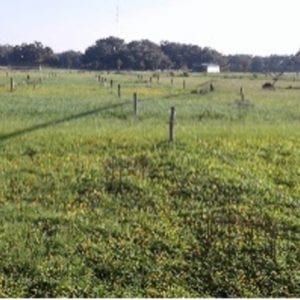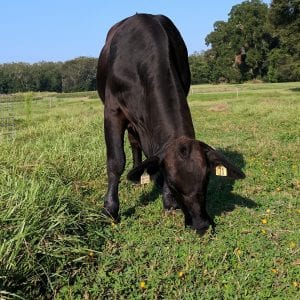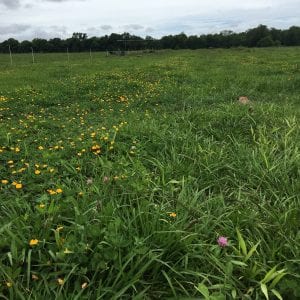Farming

Rhizoma peanut is a perennial legume with high forage yield and quality that can be planted in monoculture or in mixture with grasses.
Rhizoma peanut (RP, Arachis glabrata Benth) is well-adapted to the US Gulf Coast Region. In Alabama, it is commonly grown in the southern region. The adoption rate of using rhizoma peanut in forage systems in the region has been relatively limited due to high cost and slow rate of establishment, but new technologies and available varieties have encouraged wider adoption of plantings in the southern United States. Rhizoma peanut can be used for production of hay or managed for grazing, and a growing practice is to plant it into mixtures with warm-season perennial grasses. The use of forage legumes in warm climates has been gradually growing in interest due to increasing nitrogen (N) fertilizer costs and the potential to increase sustainability and production of grasses, especially in low fertility input systems. Thus, the greater the animal diet quality, the greater the nutrient cycling and proper distribution in forage stands, which may result in improved forage yield.
With new technologies, more available varieties, and improved management strategies, especially for weed control, adoption of rhizoma peanut plantings continues to increase in the southern United States.
Introduction to US Farmers
The genus Arachis originated in South America, and the most known species is the common edible peanut (Arachis hypogea). After harvesting common peanut, a common practice among some producers is to harvest and bale peanut vines for feeding livestock. (Remember to be aware of any pesticides that may have been used in a common or rhizoma peanut crop and follow label restrictions before feeding to avoid life threatening conditions in livestock.) Although from the same genus (Arachis), pintoi peanut (Arachis pintoi) and rhizoma peanut (Arachis glabrata) are perennial warm- season forage legumes. The pintoi peanut is adapted to relatively heavy soils with low fertility and produces viable seeds. Recently, it has been planted in south Florida for research purposes aiming to incorporate it into mixed pastures with bermudagrass and bahiagrass, but seed cost may limit its adoption.
- Figure 1. Rhizoma perennial peanut stand.
- Figure 2. Rhizoma peanut can be used for hay production or grazing.
In 1936, RP was introduced in the United States from Brazil and the initial introduction was called “Arb.” Rhizoma peanut is a tetraploid species, rhizomatous and self-pollinated with a procumbent growth habit. Due to its establishment requirements via vegetative propagation and low viable seed production, most of the improvement in RP forage production characteristics has occurred through selection and introduction, instead of breeding. In the 1960s, RP evaluation and research started in Florida, and the first variety, ‘Florigraze’, was released in 1978 and continues to be the most commonly used commercial variety. In Florida, the area planted to RP is estimated at approximately 50,000 acres and, for the extreme southern region of the United States, RP has been considered an alternative to alfalfa (Medicago sativa L.) due to challenges in alfalfa production related to pest pressure and climatic conditions. In Alabama, RP has been gradually expanding in the lower Coastal Plain.
Pintoi peanut (Arachis pintoi) is also a perennial warm- season forage legume. It is adapted to relatively heavy soils with low fertility and produces viable seeds. It has been planted recently in southern Florida for research purposes with the aim to incorporate it into mixed pastures of bermudagrass and bahiagrass; however, seed cost may limit its adoption.
Choosing a Variety
Several varieties of rhizoma peanut are available. Deciding which one(s) to plant should be based on site and climate conditions and forage system goals.The University of Florida has an ongoing variety selection program for both ornamental and forage purposes. Following are a few of the available varieties:
‘Florigraze’ is the most planted variety and can be used for both hay production and grazing management. Recently the peanut stunt virus (Cucumovirus sp.) was detected in ‘Florigraze’ rhizoma peanut pastures and has had negative effects on forage production.
‘Arbrook’ is a more upright-growing variety but is less tolerant than ‘Florigraze’ to grazing, cold weather, and heavy soils; therefore, it is primarily used for hay production.
‘UF Tito’ has a taller and less dense canopy, which favors hay production (figure 3).
‘Chico’ has a dense and short canopy favoring grazing management (figure 4).
In general, a plant’s growth habit and the ability to protect growth points should be determining factors when selecting varieties to be planted for specific forage.
- Figure 3. ‘UF Tito’ variety planted at Hague, Florida. (Photo credit: Katie Cooley)
- Figure 4. ‘Chico’ variety planted at Hague, Florida. (Photo credit: Katie Cooley)
Table 1. Most Used Commercially Available Rhizoma Perennial Peanut Varieties
Adapted from Prine et al. (1981) and Quesenberry et al. (2010)
| Variety | Date of Release | Description | 4-Year Avg. Forage Yield (lb./acre) |
|---|---|---|---|
| ‘Florigraze’ | 1978 | Most planted variety, hay or grazing management, susceptible to peanut stunt virus | 8,030 |
| ‘Arbrook’ | 1985 | Upright growth habit, low tolerance to grazing, greater drought tolerance than ‘Florigraze’ | 10,700 |
| ‘Ecoturf’ | 2008 | Decumbent growth habit, tolerates grazing, performs well in strip-planting into grass | 7,400 |
| ‘UF Peace’ | 2008 | Upright growth habit, good persistence, tolerance to diseases, favors hay production | 10,140 |
| ‘UF Tito’ | 2008 | Upright growth habit, good persistence, tolerance to diseases, favors hay production | 10,430 |
Stand Establishment
Rhizoma perennial peanut stands can take up to two growing seasons to fully establish and be available for use. Similar to hybrid bermudagrass, rhizoma peanut is established by vegetative propagation using rhizomes. Rhizomes are energy storage structures that are used to grow new shoots and promote establishment after planting. Nurseries that produce planting material generally avoid cutting source stands for at least a growing season to allow reserves to accumulate (figure 5).
- Figure 5. Two perspectives of a rhizome mat of a mature rhizoma peanut stand. (Photo credit: Lynn E. Sollenberger)
- Figure 5. Two perspectives of a rhizome mat of a mature rhizoma peanut stand. (Photo credit: Param Aryal)
It is important to understand the quality and origin of planting material because it will dictate establishment success. Good quality also helps to prevent soil pests and diseases from being carried onto your farm. There are several rhizoma peanut commercial rhizome producers in the southern United States. A regional Extension agent can help you contact them, if needed.
The planting rate for rhizoma peanut is 80 bushels of rhizomes per acre. The general rule is that 1 acre of rhizomes can plant between 15 to 20 acres. High-quality planting material should have thick (0.25 to 0.3 inch diameter) and long (greater than 10 inches) rhizomes and be planted no deeper than 1 inch.
Prior to planting, prepare the soil properly and conduct pH/fertility testing (pH around 6 is recommended). Apply lime and fertilizer according to test recommendations.
Before planting a monoculture you must also apply the proper weed control. Rhizoma peanut is highly susceptible to plant competition until it achieves ground coverage that can compete with weeds. In fact, the major issue delaying establishment is elevated weed pressure. It is therefore crucial to monitor weeds and plan for rapid control when necessary.
Best results may be achieved using nonselective herbicide such as glyphosate to kill existing vegetation, especially in sod-based grasses. Initial applications may be necessary during the previous growing season for better control of perennial grasses, with an additional application likely needed just prior to planting. Limited chemical products are available to choose from to selectively control grass and broadleaf weeds in rhizoma peanut stands without risking damage to the crop. Starting on a clean seedbed is crucial for later establishment success.
Planting date recommendations vary with rainfall regime/ patterns and generally can be conducted during late winter/early spring or summer (late March through May in Alabama). There is ongoing research to determine the best time frame in which to optimize stand establishment. Overall, better stand establishment results when plenty of rainfall occurs after planting. In areas where irrigation is available, the planting date can be better scheduled since it will not depend on timely rainfall.
- Figure 6. Rhizoma peanut pastures in monoculture (left) and in mixture with bahiagrass. (Right photo credit: Liza Garcia)
- Figure 6. Rhizoma peanut pastures in monoculture (left) and in mixture with bahiagrass. (Right photo credit: Liza Garcia)
After planting, a general rule is to apply 30 pounds of phosphorus and 60 pounds of potassium. Depending on soil fertility, initial nitrogen fertilizer might be necessary to help peanut growth after emergence. Rhizoma peanut is a legume that fixes nitrogen from the atmosphere; therefore it will not require maintenance nitrogen fertilizer applications after it is established.
Both phosphorus and potassium maintenance rates will depend mostly on the defoliation method (grazing or hay production), frequency of harvest, and soil fertility changes over time. A general rule is to apply 60 pounds of potassium yearly for systems under grazing management and soil test at least every 2 years on mature rhizoma stands to determine nutrient levels.
Forage Production and Defoliation Management
Rhizoma peanut has relatively high yield and excellent nutritive value. In monoculture systems, forage yield ranges from 7,400 to 12,200 pounds per acre per year, with digestibility and crude protein (CP) ranging from 68 to 72 percent and 15 to 18 percent, respectively. The recommended regrowth interval between harvest events is about 6 weeks.
Rhizoma peanut is used for hay production or grazing. Grazing management studies conducted in Florida have reported average daily gains from 1.3 to 2.14 pounds per day for 6-to-18-month-old steers grazing rhizoma peanut during the summer.
Rhizoma peanut also can compete with warm- season perennial grasses, such as bermudagrass and bahiagrass, in mixed pastures. The incorporation of legumes into grass-based forage systems allows for plant-fixed nitrogen to benefit the grass base; the amount varies with the management strategies used.
Well-managed and established rhizoma peanut stands generally can fix up to 200 pounds of nitrogen per acre per year. This nitrogen input improves forage and diet quality and nutrient return, which increases forage accumulation in pastures. Once in a mixture with grasses, rhizoma peanut is able to transfer nitrogen to grasses through the decomposition of high-quality above- and belowground plant material.
In the fall, rhizoma peanut goes dormant after a frost event and regrows in the spring once temperatures increase over 60 degrees F. During cool-season months, rhizoma peanut stands can be overseeded with cool-season annual forage species to extend the grazing season. A common strategy is to use a mix of small grains and clovers to provide early winter forage accumulation through March/April before emergence of rhizoma peanut from dormancy.
Weed, Pest, and Disease Control
Weed control must be properly conducted until a rhizoma peanut stand is well established and ground cover is achieved. Beginning with a clean, weed-free seedbed should be the first priority.
Many commonly used pasture and hayfield herbicides may damage rhizoma peanut while the plants are still establishing. In this case, spot spraying problematic weeds may work in small areas. For control in larger areas, especially of broadleaf species, imazapic is the only labeled option for selective broadcast applications. The use of clethodim products provides effective control of grasses as long as they are small and actively growing. For larger weeds, mechanical control by mowing vegetation above the rhizoma peanut canopy height can be a good option. A regional Extension agent can help you choose proper control options for your management scenario.
Table 2. Selective Broadcast Herbicide Options for Weed Control in Rhizoma Peanut in Alabama
| Trade Name | Active Ingredient | Use Rate | Application Timing | Notes |
|---|---|---|---|---|
| Impose | imazapic | 4 fl. oz./A | Newly sprigged & established peanut | Apply to weeds < 4 inches in height. Add 0.25% v/v nonionic surfactant. |
| Select Max; Tapout | clethodim | 9–32 fl. oz./A | Postemergence | Select Max is used for grass weeds only. Broadleaf weeds will not be controlled. Do not exceed 32 fl. oz. per application and no more than 64 fl. oz. per year. There is a 40-day harvest restriction following application. |
| Section Three | clethodim | 4–10.67 fl. oz./A | Do not apply more than 21.3 fl. oz. per season. |
A common practice among some producers is to harvest and bale peanut vines for feeding livestock. Producers must stay aware of pesticides used in a common or rhizoma peanut crop and follow any label restrictions prior to feeding to avoid life-threatening conditions in the livestock.
The peanut stunt virus (Cucumovirus sp.) has recently been detected in ‘Florigraze’ pastures and has been negatively affecting forage production. There is an ongoing effort to identify new varieties that are tolerant of the stunt virus and could be incorporated into forage production systems in the southern United States.
In general, rhizoma peanut stands should be scouted often for armyworms and other pests. Chemical control might not be economical, especially for small areas. Similarly, rhizoma peanut stands may exhibit signs of foliar diseases (i.e., leaf spot, Cercospora spp.), but chemical control usually is not feasible. If stand maturity allows, clipping or grazing the stand can be effective for controlling further spread of both pests and diseases.
Mixture with Grasses
Rhizoma peanut can be planted into mixed stands with grasses, such as bermudagrass and bahiagrass. Strip-planting is often used and consists of harvesting or controlling grass strips in existing grass stands using a herbicide (figure 7) followed by planting of rhizoma peanut. As it grows, rhizoma peanut spreads horizontally in the stand and eventually can be found in the pasture area mixed with grass. This method may help producers save money with establishment costs of rhizoma peanut.
- Figure 7. Strip-planting of rhizoma peanut into bahiagrass pastures before (left) and after establishment. (Photo credit: Jose C. B. Dubeux)
- Figure 7. Strip-planting of rhizoma peanut into bahiagrass pastures before (left) and after establishment. (Photo credit: Jose C. B. Dubeux)
Summary
Rhizoma peanut is a perennial forage legume with high yield and nutritive value characteristics. It is well adapted to the southern United States and can be managed under hay production or grazing management, including in mixtures with warm-season perennial grasses such as bermudagrass and bahiagrass.
In the past, the use of rhizoma peanut has been relatively slow due to high costs and slow establishment characteristics, but advances in new technologies and available varieties have increased its use in the coastal plain region. The incorporation of legumes into forage systems can increase sustainability in forage systems because of biological nitrogen fixation, forage accumulation potential, and quality aspects.
Acknowledgments
We would like to thank Lynn E. Sollenberger and Jose Dubeux for their contributions.
Supplemental Resources
Dubeux, J.; Sollenberger, L.; Vendramini, J.; Wallau, M.; Blount, A. Garcia-Jimenez, L.; Santos, E.; Jaramillo, D. Strip-Planting Rhizoma Peanut into Grazing Systems. SS-AGR-421. Available at https://edis.ifas.ufl.edu/ag421
Prine, G.M., E.C. French, A.R. Blount, M.J. Williams, and K.H. Quesenberry. 2010. Registration of Arblick and Ecoturf rhizoma peanut germplasms for ornamental or forage use. J. Plant Regist. 4(2): 145. doi: 10.3198/ jpr2009.07.0392crg.
Quesenberry, K.H., A.R. Blount, P. Mislevy, E.C. French, M.J. Williams, et al. 2010. Registration of ‘UF Tito’ and ‘UF Peace’ rhizoma peanut cultivars with high dry matter yields, persistence, and disease tolerance. J. Plant Regist. 4(1): 17. doi: 10.3198/jpr2009.07.0397crc.
Sollenberger, L.E., C.S. Jones, and G.M. Prine. 1989. Animal performance on dwarf elephant grass and rhizoma peanut pastures. In: Desroches, R., editor, XVI Int. Grassl. Congr. The French Grassland Society, Versailles Cedex, France, Nice, France. p. 1189–1190
Williams, M. J.; Newman, Y. C.; Blount, A. Rhizoma Perennial Peanut. SS-AGR-349. Available at https://edis. ifas.ufl.edu/ag358
Download a PDF of Rhizoma Perennial Peanut, ANR-2737.


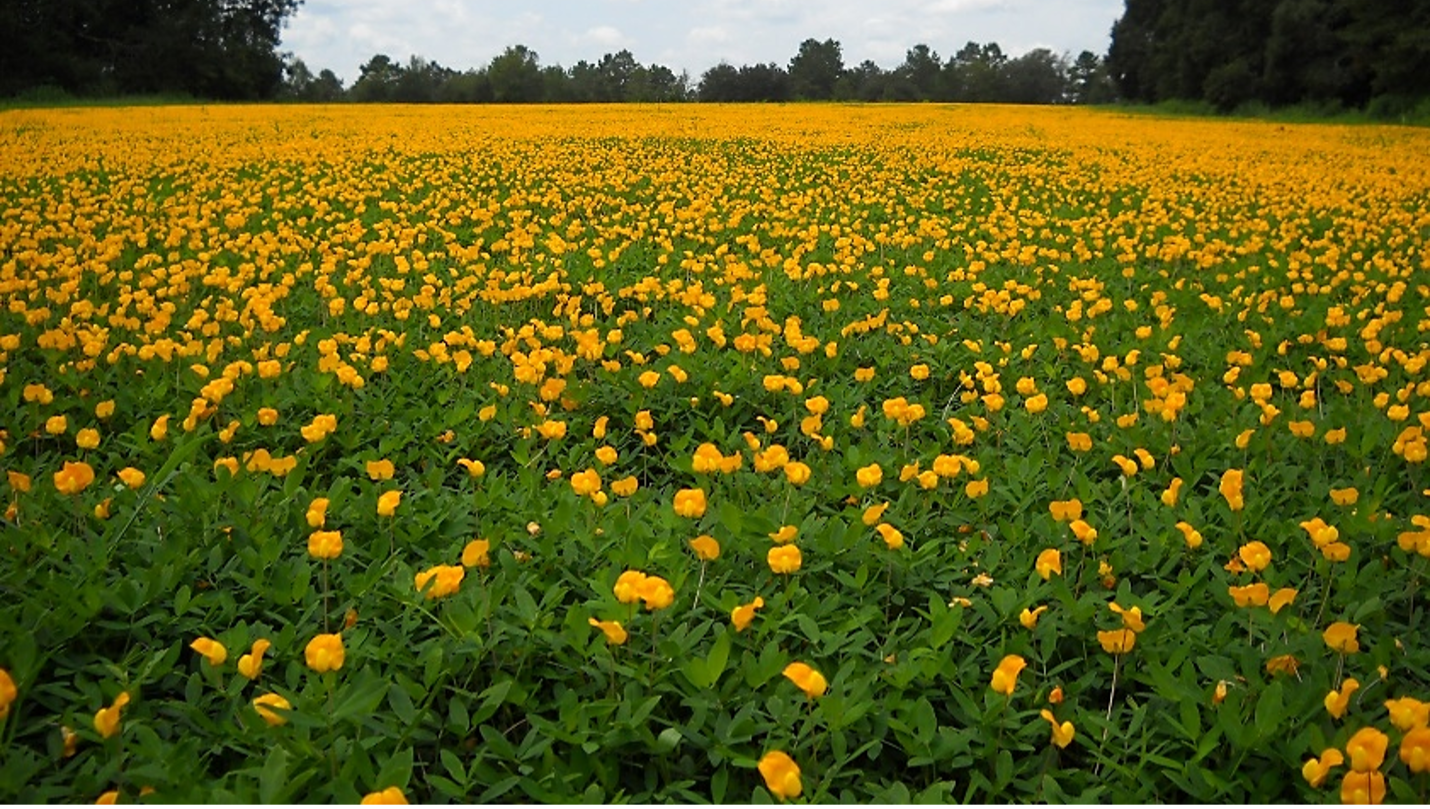
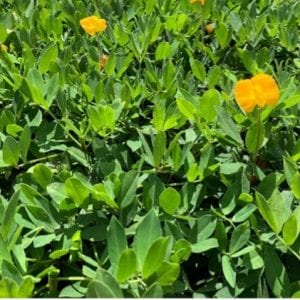
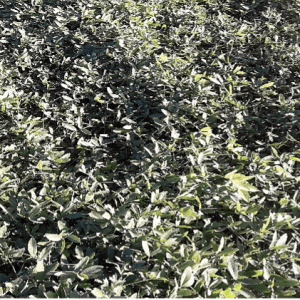
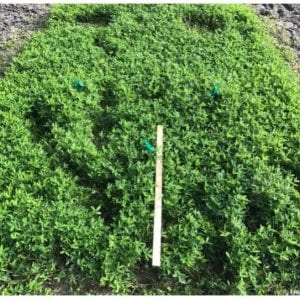
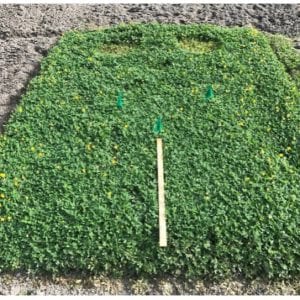
![Figure 5. Two perspectives of a rhizome mat of a mature rhizoma peanut stand. (Photo credits: Lynn E. Sollenberger [top] and Param Aryal [bottom]).](https://www.aces.edu/wp-content/uploads/2021/06/Picture3FPO-300x300.png)
![Figure 5. Two perspectives of a rhizome mat of a mature rhizoma peanut stand. (Photo credits: Lynn E. Sollenberger [top] and Param Aryal [bottom]).](https://www.aces.edu/wp-content/uploads/2021/06/Picture3.1FPO-300x300.jpg)
